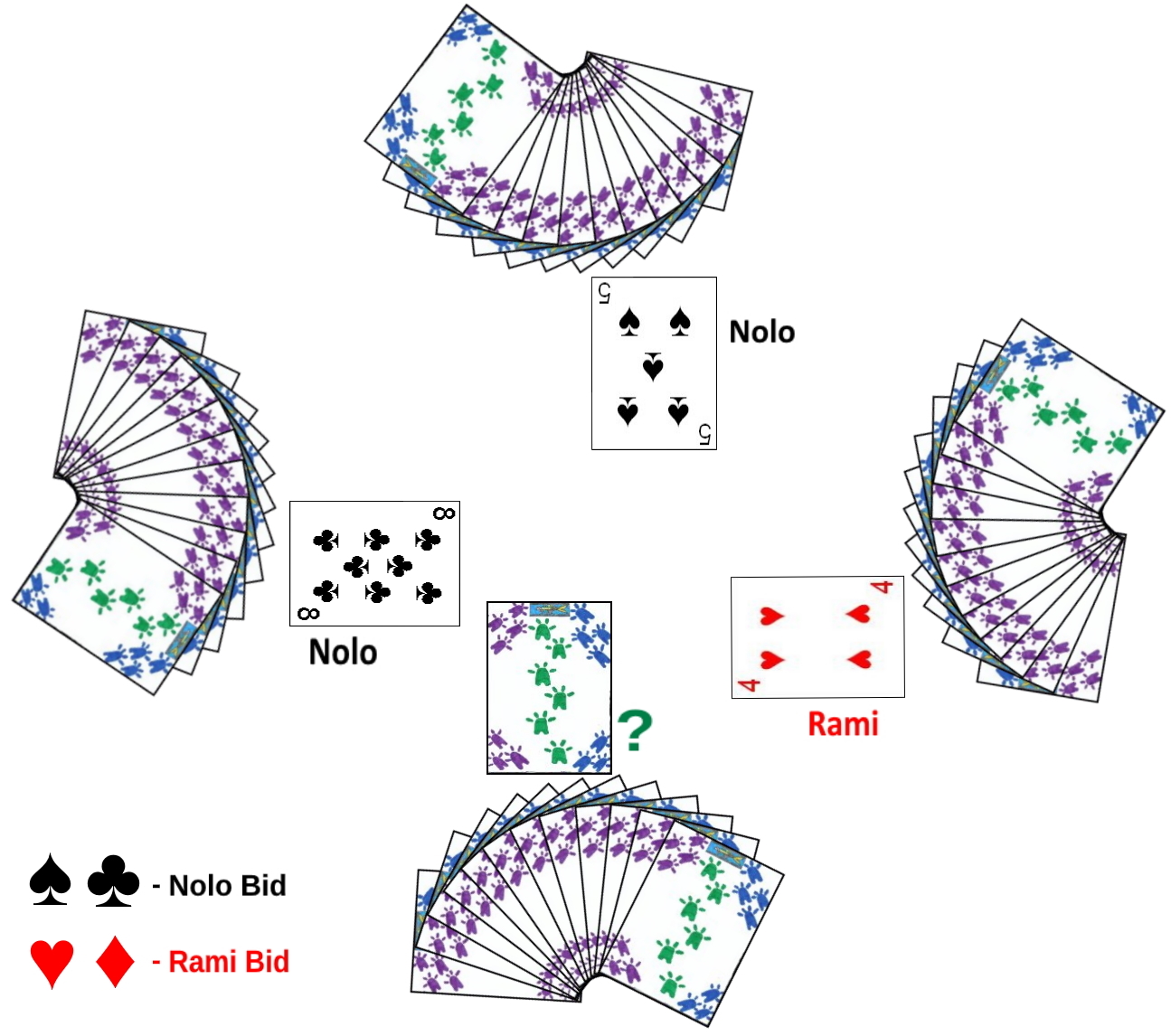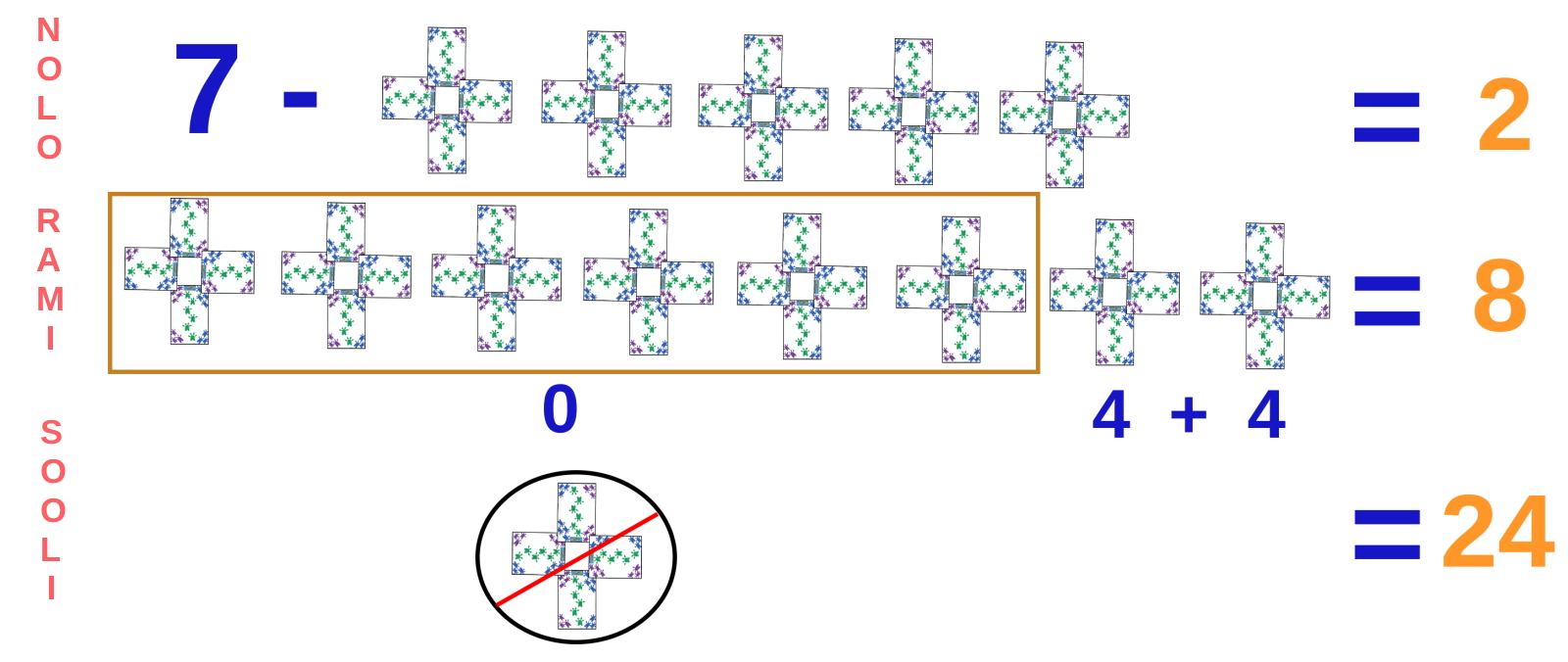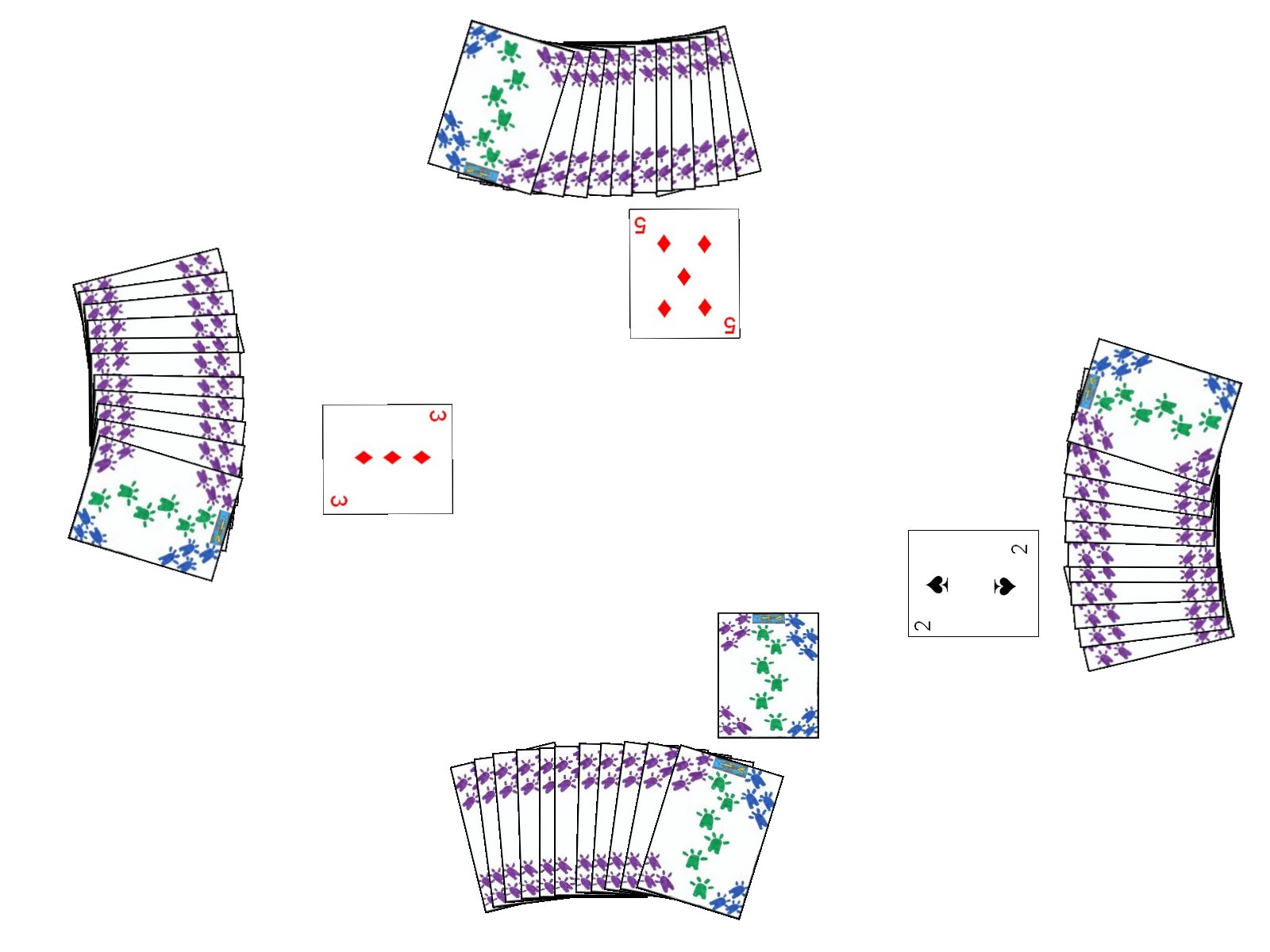How To Play Tuppi
Tuppi is a Whist-like trick taking game which originated in, and is most
widely played in, Northern Finland. Tuppi is a four-player partnership game
which uses one standard 52 card deck in play. The ranking of the cards in
Tuppi is the same as in most trick-taking games, listed from high to low; Ace, King, Queen, Jack, 10, 9, 8, 7, 6, 5, 4, 3, 2.
Determination of partnerships, seating positions, and first dealer can be performed using a variety of methods, with draw for high card often the method of choice. In that method each player draws a card from the face-down shuffled deck. Any players drawing cards that are equal in rank to that drawn by another player must draw another card, continuing to do this until drawing a uniquely ranked card. The two players drawing the highest cards play as partners against the players drawing the two lowest cards. The player drawing the highest card has first choice of seats and his partner must sit directly across from him at the table. The opposing partnership then take the two remaining seats at the table and should thus also be seated directly across from each other. The player who drew the highest card is designated the first dealer. After each hand the role of dealer rotates in a clockwise direction around the table.
Once the players are seated, the designated dealer for the hand then thoroughly shuffles the deck and offers it to the player at his immediate right for the cut. After the cut, the dealer then begins distributing the cards around the table, one by one and face-down, starting with the player at his immediate right. He continues dealing in this way, in a clockwise rotation around the table until the entire deck has been dealt out, which should leave each player with 13 cards.
 After the cards have been dealt, the players should then pick-up and examine the hands in preparation for the Auction. Unlike in most other games of this type, in Tuppi, the
auction consists of bids which are silent, with players using a card from the hand to indicate his bid for the hand. To this end, each player selects one card from his hand and places it face-down on the table in front of himself. The card selected indicates his specific intent and bid for the hand:
After the cards have been dealt, the players should then pick-up and examine the hands in preparation for the Auction. Unlike in most other games of this type, in Tuppi, the
auction consists of bids which are silent, with players using a card from the hand to indicate his bid for the hand. To this end, each player selects one card from his hand and places it face-down on the table in front of himself. The card selected indicates his specific intent and bid for the hand:
- Black Card:
A black card (card in the suit of spades or clubs) used for the bid, indicates that player is bidding to win as few tricks as possible during this hand. This bid is also called nolo.
- Red Card:
A red card (card in the suit of hearts or diamonds) used by the player for the bid indicates the player is bidding to win as many tricks as possible during the hand. This bid is called a rami bid.
A player may not bid using any card of denomination Jack or higher, or any
two as his bidding card. If, for any reason a player does not have a card in
hand which could be used to make the bid he intends, he may give his bid verbally, once the bidding cards are to be exposed (see below).
Once each player has placed his bidding card face-down in front of himself, these cards are then exposed in order, starting with the player to the immediate left of the dealer. Each player, in turn, then exposes his bid card, indicating his bid for the hand. If any player has bid a red card (rami bid), the bidding ends, and no further players need expose the bid. However, either player on the opposing team (of the player who made the rami bid) may immediately declare
"sooli" (verbally), which is an indication the player declaring sooli will play solo against both opponents (his partner will sit out the hand). If all four players bid black cards (nolo bid) the hand will be played at nolo.
After the bidding round has completed, each player returns his bid card back into his hand, which will later be used for play during the hand.
Once the auction has been completed, play of the hand begins. As mentioned previously, there are three possible game types which can be bid and played. The following describes how each is played:

- Nolo:
In a nolo hand, each player attempts to win as few tricks as possible during the hand. The player to the immediate left of the dealer leads the first card to the first trick. Whichever team earns fewer tricks during the hand earns a number of points for the hand equal to the number of total tricks won by that partnership during the hand subtracted from 7 (for instance, a partnership which won five tricks would earn 2 points on the hand).
- Rami:
In a rami hand, the partnerships attempt to win as many tricks as possible during this hand. The player to the immediate right of the first player to make the rami bid plays the first card to the first trick. At the end of a rami hand, the partnership who won the most tricks earns a number of points. If the side who first declared
"rami" wins more tricks during the hand, that team earns four points for each trick won in excess of six (i.e. twelve points for winning nine tricks). If, instead, the defending side wins more tricks during the hand, that team earns six points for each trick in excess of six (i.e. eighteen points for winning nine tricks).
- Sooli:
In a sooli hand, the partner of the player who called sooli must drop from the hand, placing his cards face-down on the table, not taking part during this hand. The player calling
"sooli" attempts to win zero tricks during the hand while the opponents attempt to force him to win at least one trick. In a sooli bid, the Ace shifts from it's position as the highest card
in each suit to being the lowest card in the deck, in each suit, while all other cards retain the normal, expected ranking. The first card to the first trick is played by the player to the immediate left of the player who called sooli, such that the sooli declarer will play the last card to that first trick. If the sooli player manages to win zero tricks during the hand, he earns 24 points for his partnership. However, if he wins one or more tricks (the game usually is stopped after the sooli player wins a trick), the opposing team wins 24 points instead.
The actual play of the hand is similar to
that of most other trick taking games. The leader to each trick may play any card of choice from his hand to start each trick. Each other player, in a clockwise direction adds one card from his hand to the trick. If he has any cards of the same suit as first played to the trick, he must play such a card to the trick.
If he does not have such a card he may play a card of any suit to that trick. The highest card of the suit originally led to the trick wins that trick, and the winner of each trick leads the first card to the next trick.
Scoring: A unique feature of Tuppi, is that only one team can have an accumulated score at any one time during the game. Thus, if one partnership has a certain accumulated score, and the opposing team manages to earn any points during that hand, the score is immediately returns to zero for each team at the end of that hand. Thus, a partnership must attempt to earn points while preventing the opponents from scoring any points. Once one partnership manages to score 52 or more points during a hand, with the opponents having a score of 0, at the end of any end, the game immediately ends with the scoring team set as the winner. During the game, the team which currently has points is called the nousussa.
In some games, signaling amongst partnerships regarding the cards in the hand is allowed. However, the signals to be used must be understood and agreed on by all players before the start of the game. Thus, with all players aware of these signals, these signals must be used cautiously and carefully to prevent the other team from also learning what cards a player has within the hand.
Whist Variations and Optional Rules
Tuppi - Tournament Rules: Due to the rising popularity of this game, Tuppi tournaments are regularly played in Norway. However, during these tournaments there are a few differences in gameplay which are strictly enforced:
- The sooli bid is not allowed and not used during tournament play.
- In Tuppi tournaments, special bidding cards are often provided to the players for making the two possible bids in the game without requiring use of a card from the hand.
- As the game can be played almost indefinitely until a winning partnership is found, during tournament play, the game is usually stopped after a set number of hands (i.e. 16). If neither team has managed to win the game before this set number of hands has been reached, the team which managed, while being nousussa, to reach the highest point total, is declared the game winner.
- No signaling or other forms of communication regarding the cards in the players' hands or the preferred card to be played is allowed during tournament play.
 |
| In Norwegian Whist, players bid using the color of a card from their hand to indicate if they intend to bid Grand or Nullo. |
Norwegian Whist: Norwegian Whist, also
commonly known as Minnesota Whist is a Whist variant in which all players "bid" simultaneously and no trump suit is used. It is played very similarly to Tuppi.
In Norwegian Whist, there are two allowable bids, Grand (sometimes called High), and Nullo (sometimes called Low or Nula). To specify their bids, each player selects one card from their hand and places it face down on the table in front of themselves. To indicate a bid of Grand, the player selects any black card and to indicate a bid of Nullo, they select any red card. In order to minimize the information revealed about a player's hand, they usually select the lowest card of the color
needed.
After each player has placed the card, the players, starting with the player to the dealer's immediate right, exposes the card they placed. If the card exposed is a red card, the bid continues to the next player in turn who then reveals their own card. If the card is black, the bidding stops immediately and the hand is played at Grand (no other players card need be exposed). If all four players show a black card, the hand is played Nullo. In the very rare instance a player has been dealt cards of only one color, they may, at their option, expose their entire hand which immediately ends the current hand with no play or score being completed for the hand and the same dealer redealing.
A bid of Grand indicates a bid for a partnership to win 7 or more tricks. A bid of Nullo indicates the partnerships intention to win 6 or fewer tricks. After being decided in the bidding if the Game for the hand is to be Grand or Nullo, the players add their exposed card back into their hand before play begins.
If the game is to be played at Grand, the player to the immediate right of the first person to have exposed a black card plays the first card to the first trick. In the case the game is to be played at Nullo, the player to the immediate left of the dealer leads the first card to the first trick.
Each player in turn, then plays one card to the trick. Each player must play a card of the suit first led to the trick if they have one. If they do not, they may play any card to the trick. The highest card of the same suit as originally led to the trick wins the trick. The winner of each trick leads the first card to the next trick.
After all tricks have been played and won, the scoring is determined. If the game was played at Grand, the partnership which won the most tricks scores one point for each odd trick (tricks over 6) won. If the game was played at Nullo instead, the partnership who won more tricks loses 1 point for each odd trick won during the hand. Negative scores are possible in Norwegian Whist.
Once one partnership reaches or exceeds 13 points at the end of a hand, that team is declared the winner of the game.
Copyright © 2015
CatsAtCards.com. All rights reserved.

 After the cards have been dealt, the players should then pick-up and examine the hands in preparation for the Auction. Unlike in most other games of this type, in Tuppi, the
auction consists of bids which are silent, with players using a card from the hand to indicate his bid for the hand. To this end, each player selects one card from his hand and places it face-down on the table in front of himself. The card selected indicates his specific intent and bid for the hand:
After the cards have been dealt, the players should then pick-up and examine the hands in preparation for the Auction. Unlike in most other games of this type, in Tuppi, the
auction consists of bids which are silent, with players using a card from the hand to indicate his bid for the hand. To this end, each player selects one card from his hand and places it face-down on the table in front of himself. The card selected indicates his specific intent and bid for the hand:

